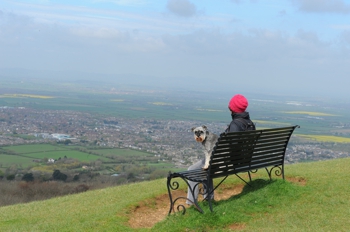 At 1,083 feet or 330 metres above sea level, the summit of Cleeve Hill boasts the highest point in the Cotswolds. Whilst this hill is small in comparison to its Welsh and Scottish cousins, the views that it offers are outstanding and rival those seen from its Celtic counterparts. Cleve Hill is famous for those who like walking through the countryside and enjoying impressive landscapes of the Cotswolds with clear views of Cheltenham and beyond. There is a looped trail that includes the summit, which will take around 3-hours for someone with moderate fitness to complete.
At 1,083 feet or 330 metres above sea level, the summit of Cleeve Hill boasts the highest point in the Cotswolds. Whilst this hill is small in comparison to its Welsh and Scottish cousins, the views that it offers are outstanding and rival those seen from its Celtic counterparts. Cleve Hill is famous for those who like walking through the countryside and enjoying impressive landscapes of the Cotswolds with clear views of Cheltenham and beyond. There is a looped trail that includes the summit, which will take around 3-hours for someone with moderate fitness to complete.
Getting There
The most popular ascent up Cleeve Hill starts at the Cleeve Hill Golf Course. Visitors travelling by car can take the B4632 out of Cheltenham and follow this road until it leads to the Golf Course Clubhouse. There is free parking available at the quarry, which is opposite the golf course. Alternatively, the Cleeve Hill Golf Course is on a bus route with regular buses to and from Cheltenham.
For visitors who do not wish to undertake the ascent on foot, Aggs Hill (via Harp Hill from Cheltenham) offers access very close to the summit trig point at the south of the hill. However, the summit is a relatively flat point and better views are obtainable from the north side of the hill, which is not accessible by car.
The Ascent
To access the best views from Cleeve Hill, it is best to start the ascent at the quarry (Grid Reference: SO989272) and follow the national trail – the Cotswolds Way – up a relatively steep climb. You will eventually reach the first trig point at 317 metres above sea level. Whilst this does not mark the highest point of Cleeve Hill, it is where visitors tend to find the most spectacular views across the Vale of Evesham, which is the inspiration behind Tolkien’s Middle Earth. You will also see stunning views across Cheltenham, as well as into Wales. The unsurpassed panorama makes this an excellent stopping point on the walk. The point is also marked by “The Single Beech,” the highest tree in the Cotswolds, which holds a number of plaques dedicated to the memory of people who have enjoyed this beautiful spot.
To reach the main summit, walkers can continue from the first trig point along the Cotswolds Way and eventually turn left at Whites Barn toward a number of radio masts. There is another trig point here marking the 330-metre elevation – the highest point of Cleeve Hill.
Points of Interest
When doing a circuit around Cleeve Hill, keep your eyes out for a number of points of interest. These include:
- Iron Age Hillfort – Whilst little of the original hillfort remains due to quarrying and erosion, this iron age hillfort is still a grand reminder of our tribal heritage
- Cross Dyke – The Cross Dyke is a long ditch thought to have been created in the Bronze Age and was designed to mark out territory
- Huddlestone’s Table – According to legend, this stone square block was once the table of King Kenulf of Mercia from the Saxon period
Nearby Places to Visit
Once walkers have finished their ascent, refreshments can be found in the Cleeve Hill Golf Course restaurant, which is also open to non-members and serves a reasonable range of meals, drinks and light snacks. Furthermore, the nearby villages of Bishops Cleeve and Woodmancote have a number of pubs and restaurants that serve traditional and modern British cuisine in picturesque chocolate-box village settings.
